Positron Spectroscopy of Nanodiamonds after Hydrogen Sorption
Abstract
:1. Introduction
2. Experimental Methods
2.1. Materials
2.2. Sample Preparation
2.3. Characterization
2.4. Hydrogenation Studies
2.5. Positron-Annihilation Studies
3. Results and Discussions
3.1. Sample Preparation
3.2. Structure Investigation
3.3. Hydrogen Storage Capacity
3.4. Positron Spectroscopy
4. Conclusions
Acknowledgments
Author Contributions
Conflicts of Interest
References
- Schlapbach, L.; Zuttel, A. Hydrogen-storage materials for mobile applications. Nature 2001, 414, 353–358. [Google Scholar] [CrossRef] [PubMed]
- Ross, D.K. Hydrogen storage: The major technological barrier to the development of hydrogen fuel cell cars. Vacuum 2006, 80, 1084–1089. [Google Scholar] [CrossRef]
- Yurum, Y.; Taralp, A.; Veziroglu, T.N. Storage of hydrogen in nanostructured carbon materials. Int. J. Hydrogen Energy 2009, 34, 3784–3798. [Google Scholar] [CrossRef] [Green Version]
- Xu, W.-C.; Takahashi, K.; Matsuo, Y.; Hattori, Y.; Kumagai, M.; Ishiyama, S.; Kaneko, K.; Iijima, S. Investigation of hydrogen storage capacity of various carbon materials. Int. J. Hydrogen Energy 2007, 32, 2504–2512. [Google Scholar] [CrossRef]
- Orinakova, R.; Orinak, A. Recent applications of carbon nanotubes in hydrogen production and storage. Fuel 2011, 90, 3123–3140. [Google Scholar] [CrossRef]
- Jimenez, V.; Ramirez-Lucas, A.; Sanchez, P.; Valverde, J.L.; Romero, A. Hydrogen storage in different carbon materials: Influence of the porosity development by chemical activation. Appl. Surf. Sci. 2012, 258, 2498–2509. [Google Scholar] [CrossRef]
- Karatepe, N.; Yuca, N. Hydrogen adsorption on carbon nanotubes purified by different methods. Int. J. Hydrogen Energy 2011, 36, 11467–11473. [Google Scholar] [CrossRef]
- Jimenez, V.; Ramırez-Lucas, A.; Sanchez, P.; Valverde, J.L.; Romero, A. Improving hydrogen storage in modified carbon materials. Int. J. Hydrogen Energy 2012, 37, 4144–4160. [Google Scholar] [CrossRef]
- Stanishevsky, A.V.; Walock, M.J.; Catledge, S.A. Surface modification and stability of detonation nanodiamonds in microwave gas discharge plasma. Appl. Surf. Sci. 2015, 357, 1403–1409. [Google Scholar] [CrossRef]
- Laptev, R.S.; Lider, A.M.; Bordulev, Y.S.; Kudiiarov, V.N.; Garanin, G.V.; Wang, W.; Kuznetsov, P.V. Investigation of defects in hydrogen-saturated titanium by means of positron annihilation techniques. Defect Diffus. Forum 2015, 365, 232–236. [Google Scholar] [CrossRef]
- Kuznetsov, P.V.; Mironov, Y.P.; Tolmachev, A.I.; Bordulev, Y.S.; Laptev, R.S.; Lider, A.M.; Korznikov, A. Positron spectroscopy of defects in submicrocrystalline nickel after low-temperature annealing. Phys. Solid State 2015, 57, 219–228. [Google Scholar] [CrossRef]
- Laptev, R.S.; Kudiiarov, V.N.; Bordulev, Y.S.; Mikhaylov, A.A.; Lider, A.M. Gas-phase hydrogenation influence on defect behavior in titanium-based hydrogen-storage material. Prog. Nat. Sci. Mater. Int. 2017, 27, 105–111. [Google Scholar] [CrossRef]
- Pushilina, N.S.; Kudiiarov, V.N.; Laptev, R.S.; Lider, A.M.; Teresov, A.D. Microstructure changes in Zr-1Nb alloy after pulsed electron beam surface modification and hydrogenation. Surf. Coat. Technol. 2015, 284, 63–68. [Google Scholar] [CrossRef]
- Chakrabarti, K.; Nambissan, P.M.G.; Mukherjee, C.D.; Bardhan, K.K.; Kim, C.; Yang, K.S. Positron annihilation spectroscopy of polyacrylonitrile-based carbon fibers embedded with multi-wall carbon nanotubes. Carbon 2006, 44, 948–953. [Google Scholar] [CrossRef]
- Budziak, A.; Dryzek, J.; Krawczyk, J.; Zieliński, P.M. Calorimetric and positron lifetime measurements of hydrogenated carbon nanocones. Acta Phys. Pol. A 2010, 117, 574–577. [Google Scholar] [CrossRef]
- Ma, X.; Wang, H.; Wang, H.; Brien-Abraham, J.O.; Lin, Y.S. Pore structure characterization of supported polycrystalline zeolite membranes by positron annihilation spectroscopy. J. Membr. Sci. 2015, 477, 41–48. [Google Scholar] [CrossRef]
- McGuire, S.; Keeble, D.J. Positron lifetimes of polycrystalline metals: A positron source correction study. J. Appl. Phys. 2006, 100, 103504. [Google Scholar] [CrossRef]
- Kullmann, J.; Enke, D.; Thraenert, S.; Krause-Rehberg, R.; Inayat, A. Characterization of nanoporous monoliths using nitrogen adsorption and positronium annihilation lifetime spectroscopy. Colloids Surf. A Physicochem. Eng. Asp. 2010, 357, 17–20. [Google Scholar] [CrossRef]
- Gidley, D.W.; Peng, H.; Vallery, R.S. Positron Annihilation as a Method to Characterize Porous Materials. Annu. Rev. Mater. Res. 2006, 36, 49–79. [Google Scholar] [CrossRef]
- Kulman, J.; Enke, D.; Thraenert, S.; Krause-Rehberg, R.; Beiner, M. Characterization of pore filling of mesoporous host systems by means of positronium annihilation lifetime spectroscopy (PALS). Opt. Appl. 2012, 42, 281–286. [Google Scholar]
- Gulidova, L.V.; Kudiyarov, V.N.; Lider, A.M. The Investigation of Hydrogen Sorption-desorption Process by Carbon Material with Content of Carbon Nanotubes. In Proceedings of the 7th International Forum on Strategic Technology (IFOST), Tomsk, Russia, 18–21 September 2012; Volume 2, pp. 58–61. [Google Scholar]
- Kudiiarov, V.N.; Gulidova, L.V.; Pushilina, N.S.; Lider, A.M. Application of automated complex gas reaction controller for hydrogen storage materials investigation. Adv. Mater. Res. 2013, 740, 690–693. [Google Scholar] [CrossRef]
- Dryzek, J.; Singleton, D. Implantation profile and linear absorption coefficients for positrons injected in solids from radioactive sources 22Na and 68Ge/68Ga. Nucl. Instrum. Methods Phys. Res. B 2006, 252, 197–204. [Google Scholar] [CrossRef]
- Kansy, J.; Suzuki, T. Delayed formation and localisation of positronium in polymers at low temperatures. Radiat. Phys. Chem. 2007, 76, 759–765. [Google Scholar] [CrossRef]
- Rehberg, R.K.; Leipner, H.S. Positron Annihilation in Semiconductors: Defect Studies; Springer: Berlin, Germany, 1999. [Google Scholar]
- Mantl, S.; Triftshäuser, W. Defect annealing studies on metals by positron annihilation and electrical resitivity measurements. Phys. Rev. B Solid State 1978, 17, 1645. [Google Scholar] [CrossRef]
- Liszkay, L.; Corbel, C.; Baroux, L.; Hautojarvi, P.; Bayhan, M.; Brinkman, A.W.; Tatarenko, S. Positron trapping at divacancies in thin polycrystalline CdTe films deposited on glass. Appl. Phys. Lett. 1994, 64, 1380. [Google Scholar] [CrossRef]
- Hasegawa, M.; Kajino, M.; Kuwahara, H.; Kuramoto, E.; Takenaka, M.; Yamaguchi, S. Materials Science Forum; Trans Tech Publications: Zürich, Switzerland, 1992; Volume 105, pp. 1041–1046. [Google Scholar]
- Murakami, H.; Sato, K.; Kanazawa, I.; Sano, M. Positron Annihilation in Carbon Nanotubes Studied by Coincidence Doppler Broadening Spectroscopy. Acta Phys. Pol. A 2008, 113, 1479–1484. [Google Scholar] [CrossRef]
- Jean, Y.C.; Venkateswaran, K.; Parsai, E.; Cheng, K.L. Temperature dependence of positron annihilation characteristics on the surfaces of graphite powders. Appl. Phys. A 1984, 35, 169–176. [Google Scholar] [CrossRef]
- Guo, W.F.; Chen, X.L.; Du, H.J.; Weng, H.M.; Ye, B.J. Positron Annihilation in Carbon Nanotubes. Mater. Sci. Forum 2009, 607, 198–200. [Google Scholar] [CrossRef]
- Tao, S.J. Positronium Annihilation in Molecular Substances. J. Chem. Phys. 1972, 56, 5499–5510. [Google Scholar] [CrossRef]
- Eldrup, M.; Lightbody, D.; Sherwood, J.N. The temperature dependence of positron lifetimes in solid pivalic acid. Chem. Phys. 1981, 63, 51–58. [Google Scholar] [CrossRef]
- Shiryaev, A.A.; van Veen, A.; Schut, H.; Kruseman, A.C.; Zakharchenko, O.D. Positron beam investigations of natural cubic and coated diamonds. Radiat. Phys. Chem. 2000, 58, 625–632. [Google Scholar] [CrossRef]
- Mäki, J.M.; Kuittinen, T.; Korhonen, E.; Tuomisto, F. Positron lifetime spectroscopy with optical excitation: A case study of natural diamond. New J. Phys. 2012, 14, 035023. [Google Scholar] [CrossRef]
- Dannefaer, S.; Pu, A.; Kerr, D. Positron annihilation study of vacancies in type IIa diamonds illuminated with monochromatic light. Diam. Relat. Mater. 2001, 10, 2113–2117. [Google Scholar] [CrossRef]
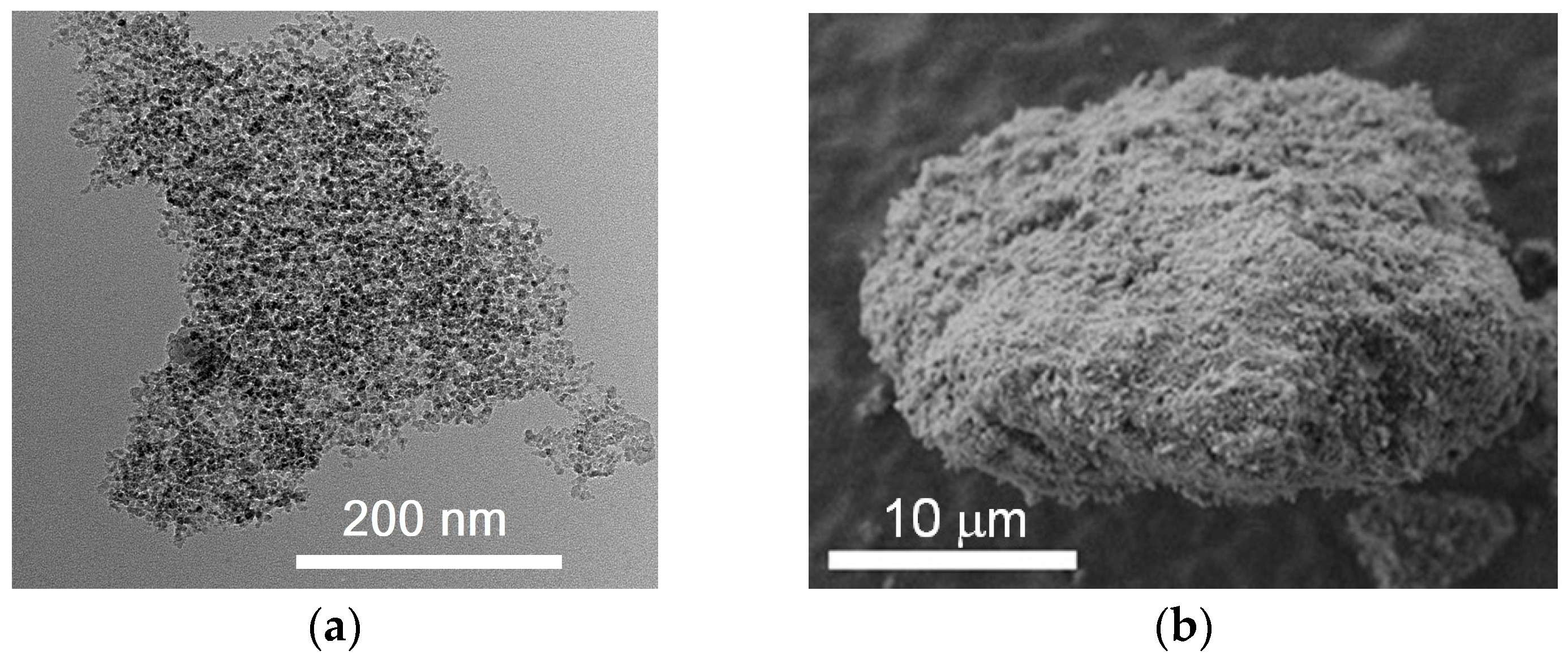
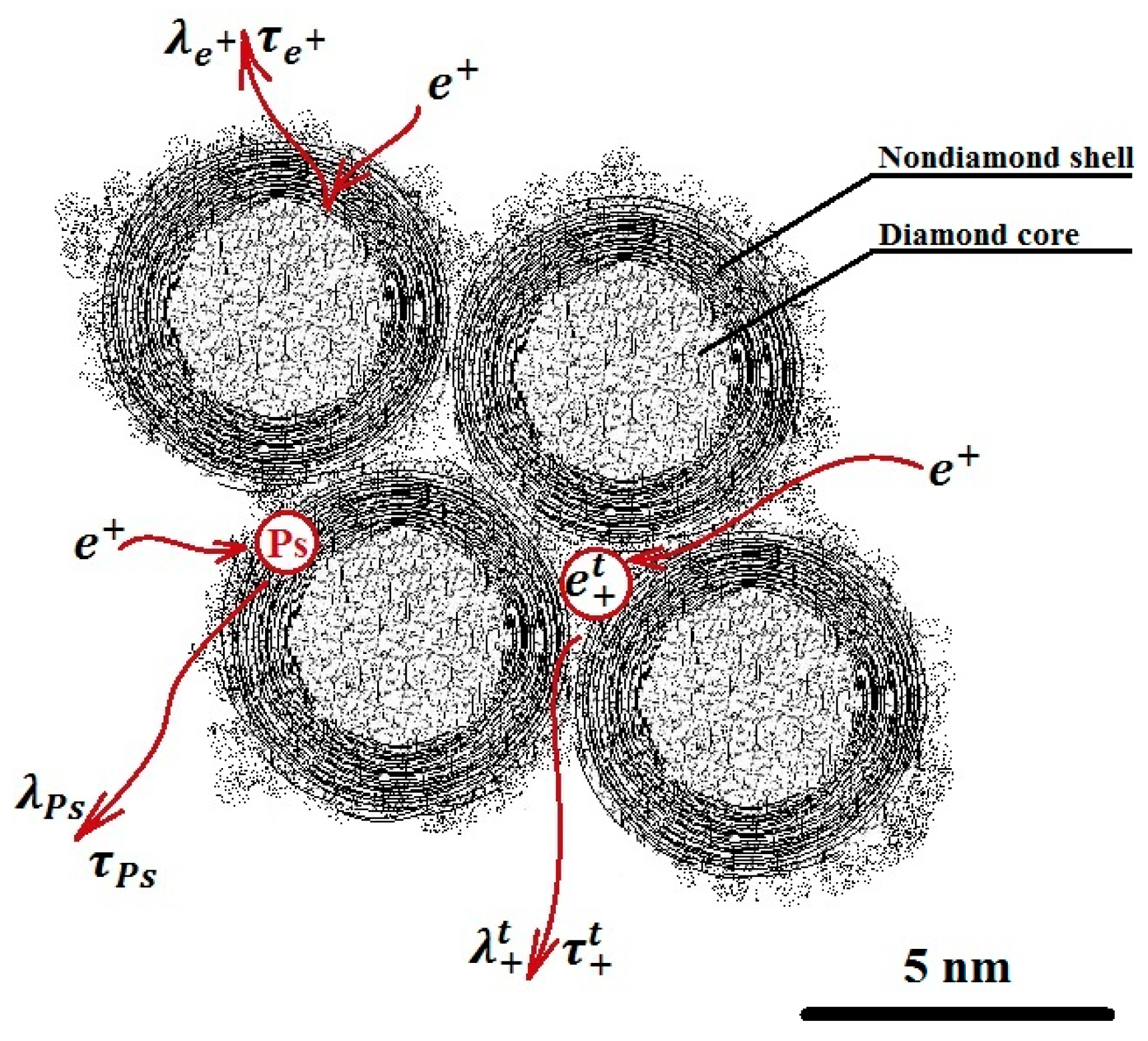

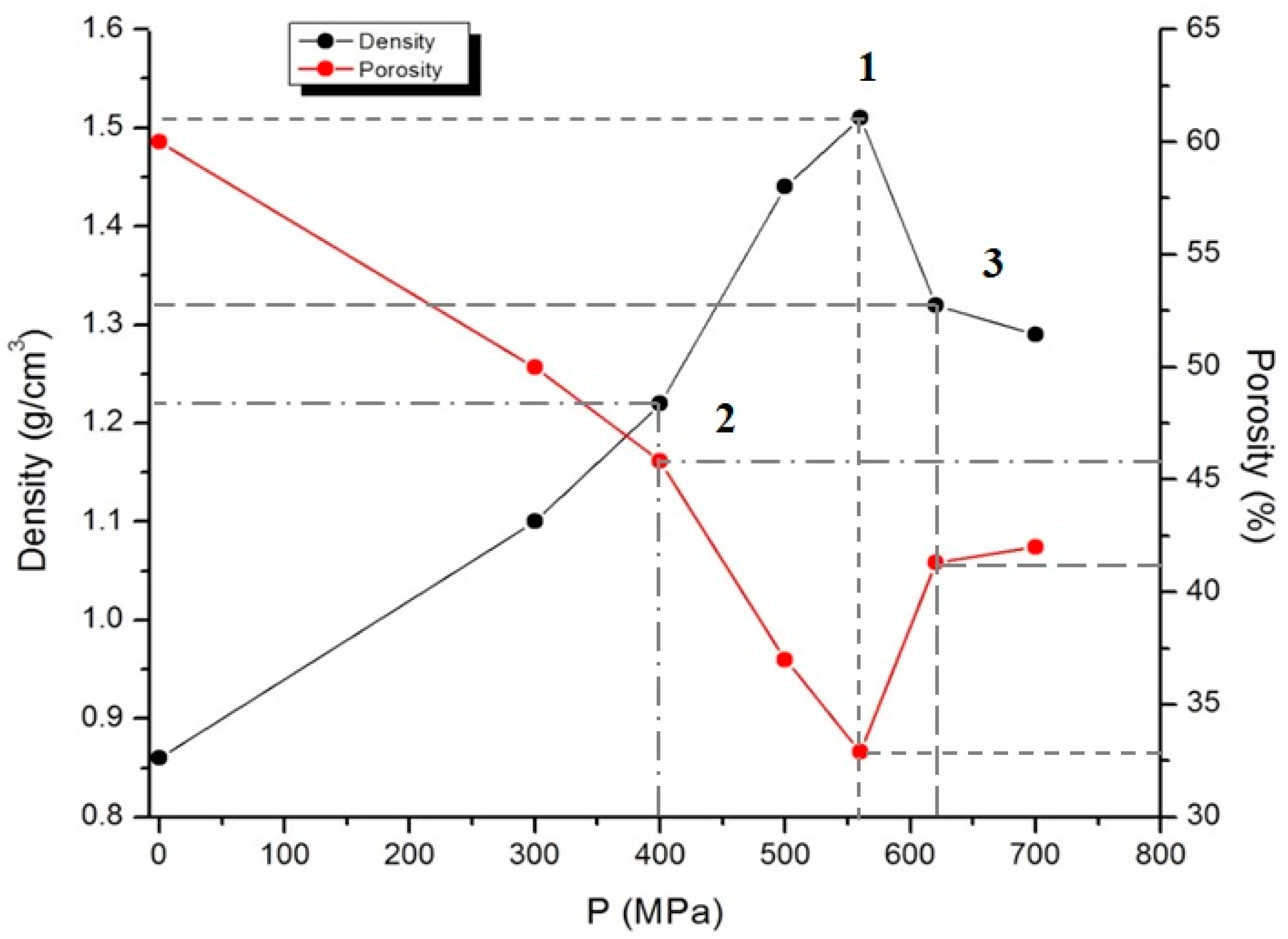
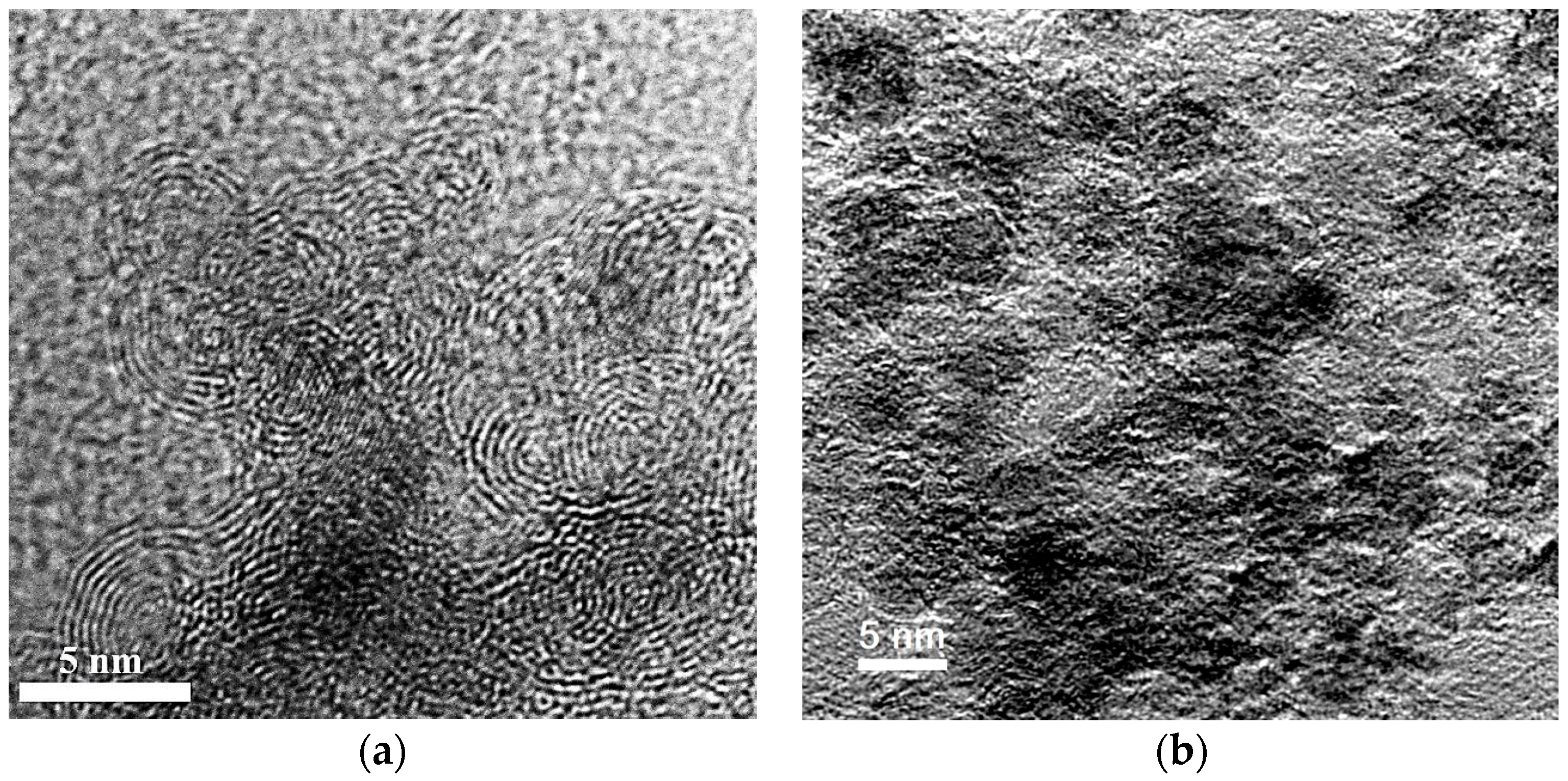
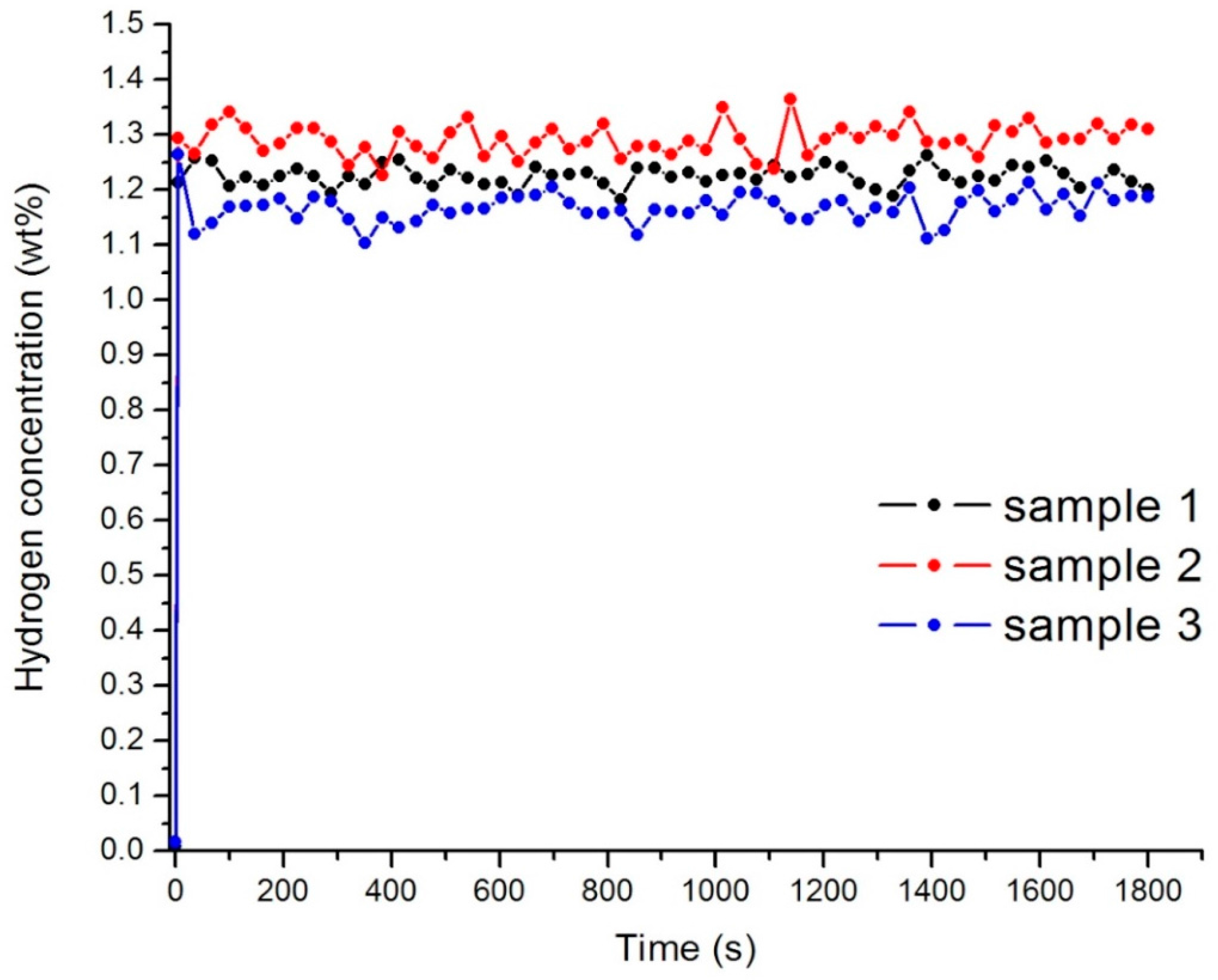
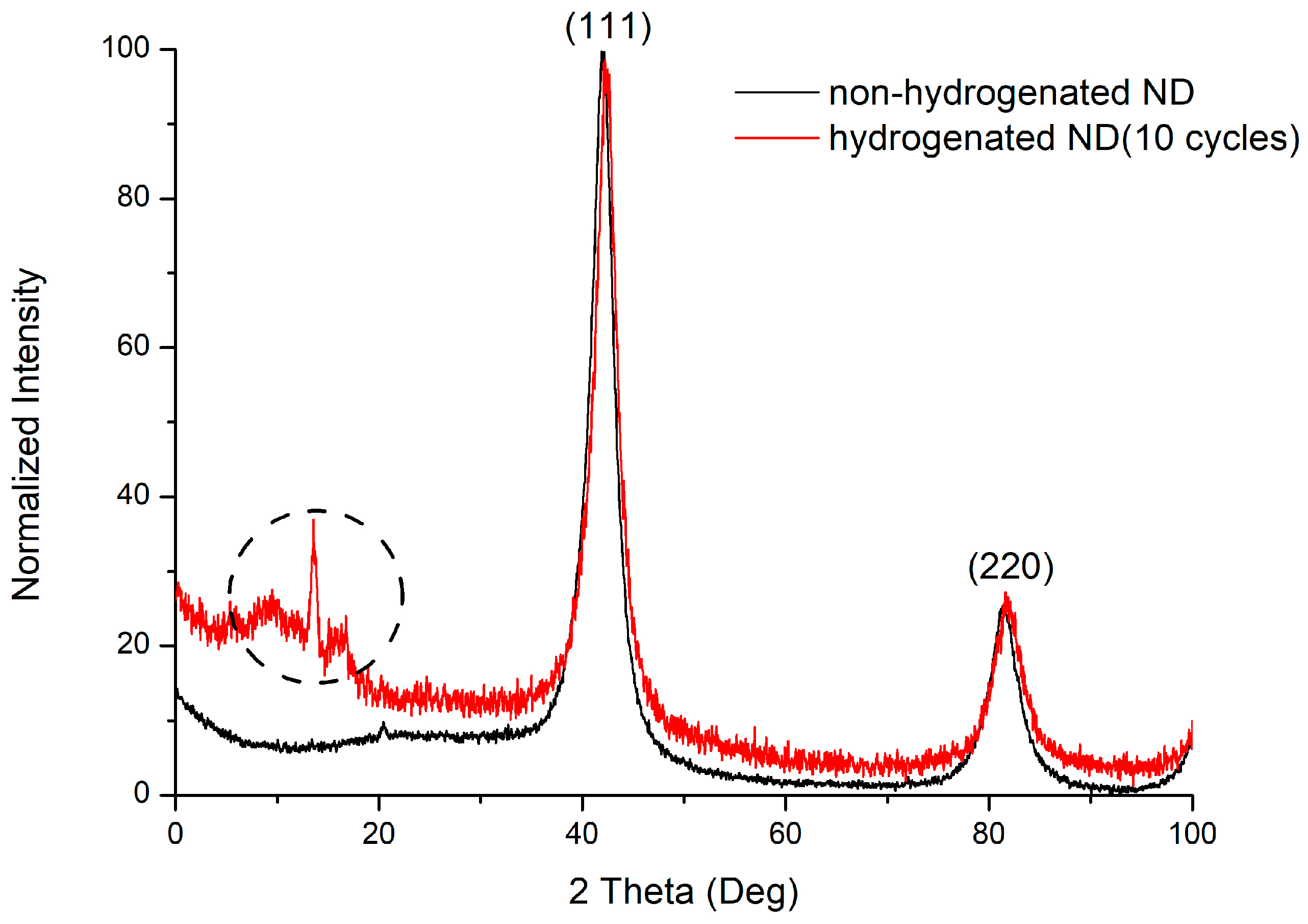
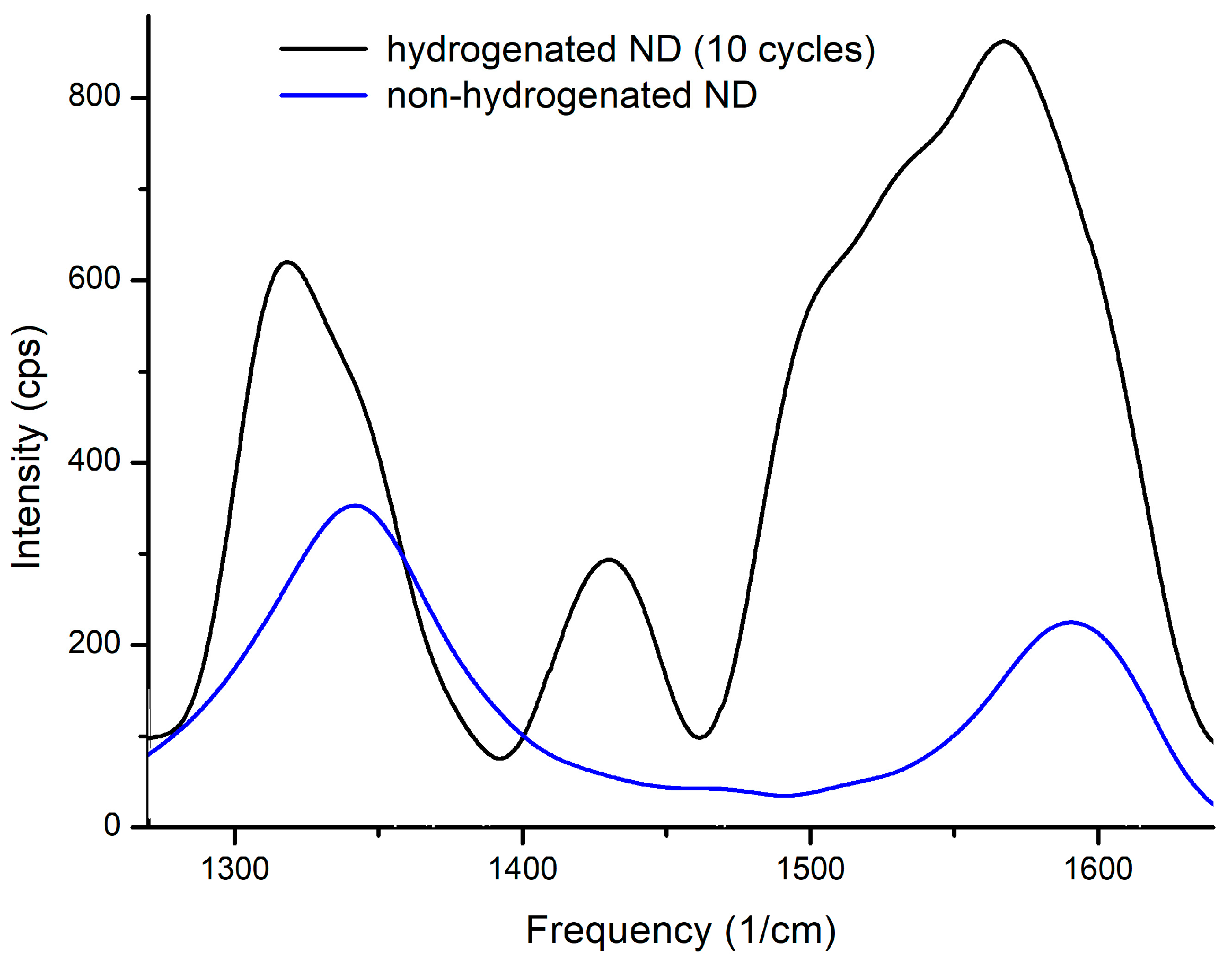

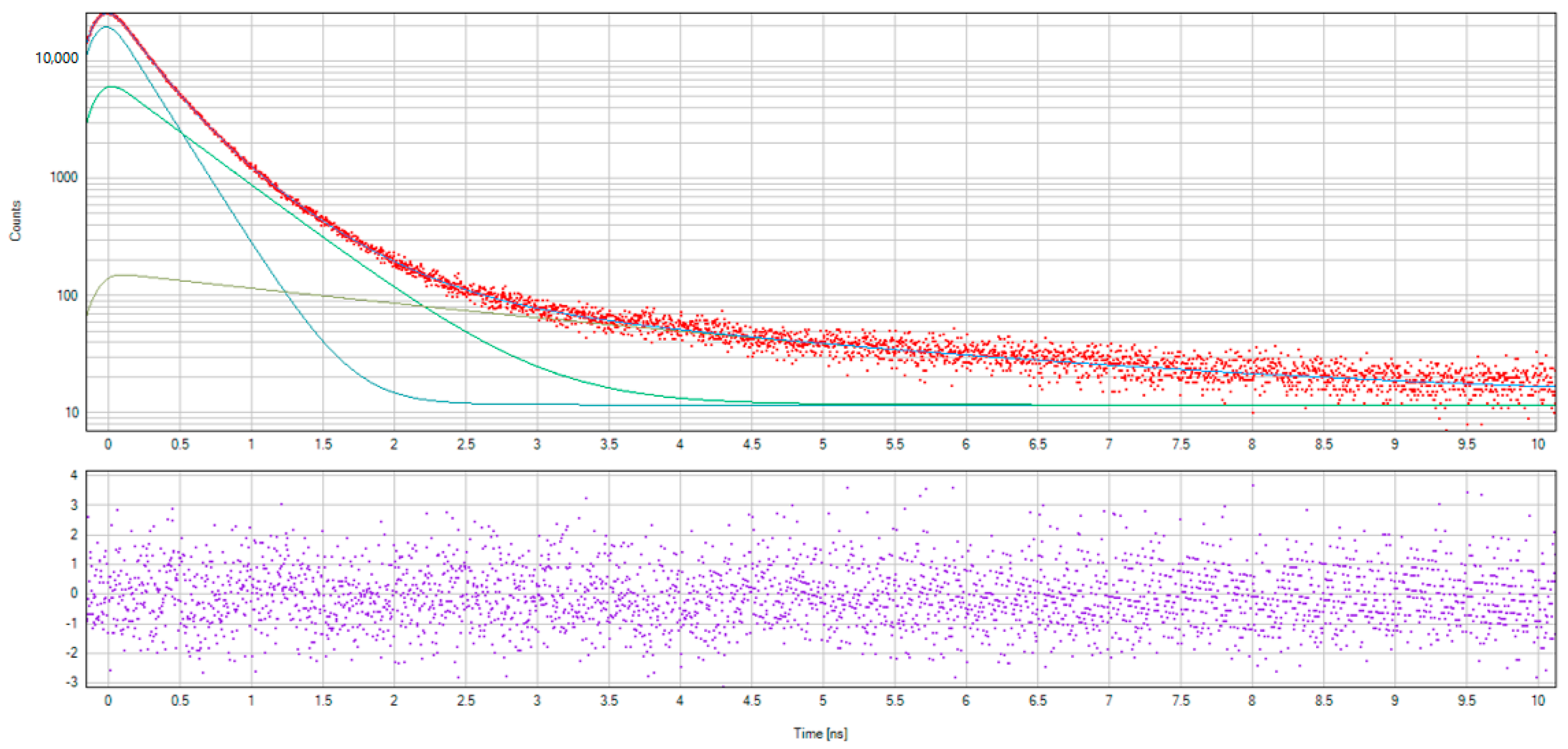
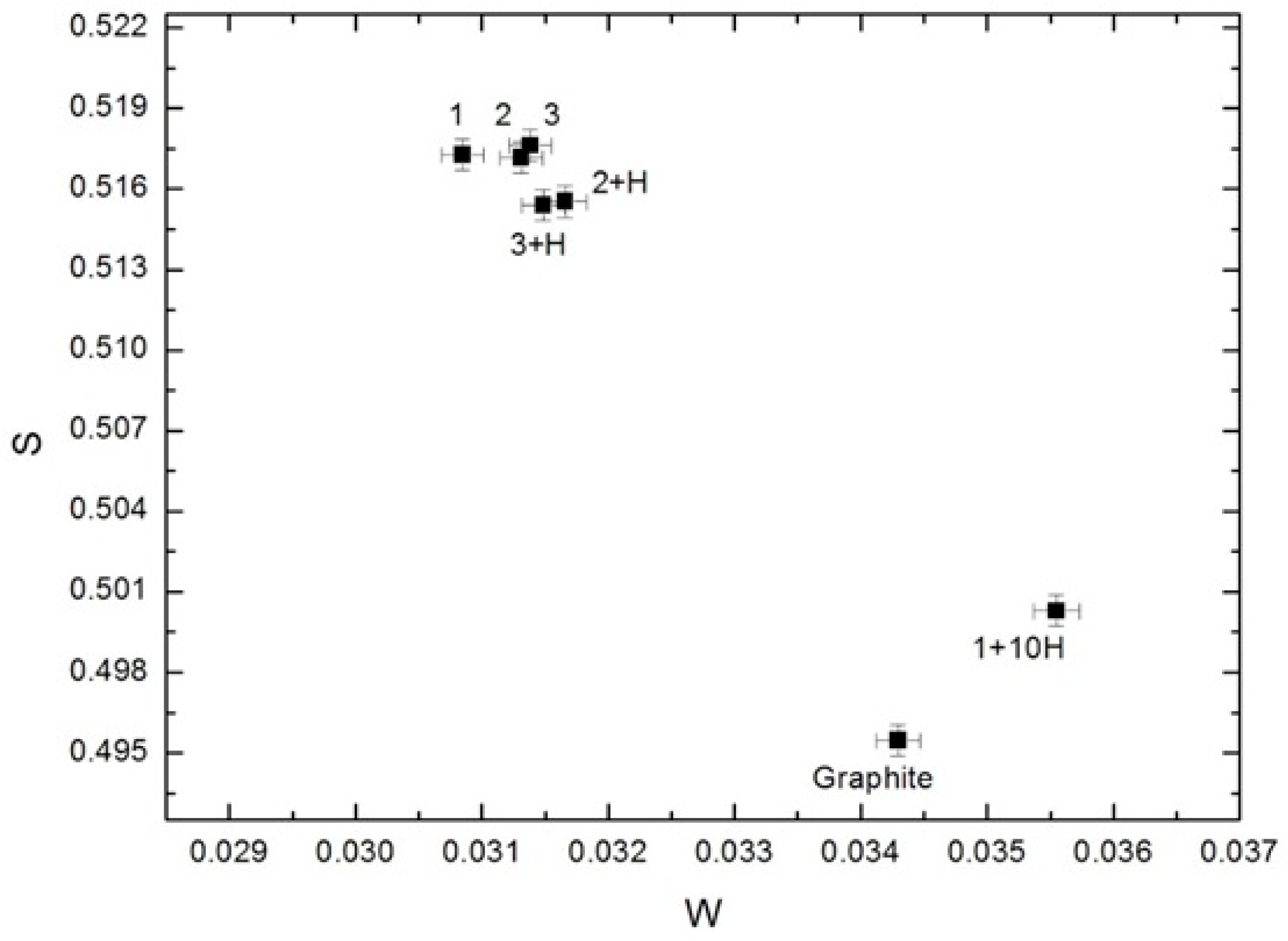
| Sample | ID | IG | ID/IG |
|---|---|---|---|
| 0 cycles | 352 | 213 | 1.65 |
| 1 (10 cycles) | 623 | 891 | 0.70 |
| State | τo-Ps, ns | Io-Ps, % | τT, ns | IT, % | μ, ns−1 | τfree, ns | κ, ns−1 |
|---|---|---|---|---|---|---|---|
| 1 | 3.05 ± 0.04 | 3.35 | 0.51 ± 0.01 | 14.8 | 0.60 ± 0.02 | 0.30 ± 0.03 | 0.18 ± 0.01 |
| 2 | 3.13 ± 0.06 | 2.9 | 0.52 ± 0.01 | 13.6 | 0.53 ± 0.02 | 0.31 ± 0.04 | 0.16 ± 0.01 |
| 3 | 3.18 ± 0.06 | 3.28 | 0.53 ± 0.02 | 13.2 | 0.51 ± 0.02 | 0.31 ± 0.04 | 0.17 ± 0.01 |
| 2 (1 cycle) | 4.47 ± 0.08 | 2.82 | 0.59 ± 0.01 | 10.3 | 0.37 ± 0.01 | 0.32 ± 0.04 | 0.14 ± 0.01 |
| 3 (1 cycle) | 4.1 ± 0.1 | 3.19 | 0.69 ± 0.09 | 7.37 | 0.24 ± 0.07 | 0.34 ± 0.04 | 0.14 ± 0.01 |
| 1(10 cycles) | 2.35 ± 0.04 | 5.07 | 0.42 ± 0.01 | 42.3 | 2.91 ± 0.15 | 0.29 ± 0.02 | 0.46 ± 0.01 |
| Graphite | - | - | 0.42 ± 0.01 | 23.10 | 2.7 ± 0.1 | 0.28 ± 0.02 | - |
© 2018 by the authors. Licensee MDPI, Basel, Switzerland. This article is an open access article distributed under the terms and conditions of the Creative Commons Attribution (CC BY) license (http://creativecommons.org/licenses/by/4.0/).
Share and Cite
Nikitina, L.; Laptev, R.; Abzaev, Y.; Lider, A.; Ivashutenko, A. Positron Spectroscopy of Nanodiamonds after Hydrogen Sorption. Nanomaterials 2018, 8, 36. https://doi.org/10.3390/nano8010036
Nikitina L, Laptev R, Abzaev Y, Lider A, Ivashutenko A. Positron Spectroscopy of Nanodiamonds after Hydrogen Sorption. Nanomaterials. 2018; 8(1):36. https://doi.org/10.3390/nano8010036
Chicago/Turabian StyleNikitina, Lyudmila, Roman Laptev, Yuri Abzaev, Andrey Lider, and Alexander Ivashutenko. 2018. "Positron Spectroscopy of Nanodiamonds after Hydrogen Sorption" Nanomaterials 8, no. 1: 36. https://doi.org/10.3390/nano8010036







